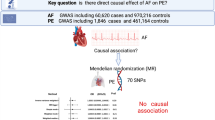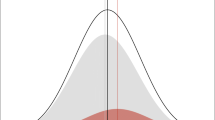Abstract
Atrial fibrillation (AF) is the most common cardiac rhythm disorder at the clinical setting and accounts for up to 15% of all strokes. Recent genome-wide association studies (GWAS) identified two single nucleotide polymorphisms (SNPs), rs2106261 and rs7193343 in ZFHX3 (zinc finger homeobox 3 gene) and rs13376333 in KCNN3 (encoding a potassium intermediate/small conductance calcium-activated channel, subfamily N, member 3) that showed significant association with AF in multiple populations of European ancestry. Here, we studied a Chinese Han, GeneID cohort consisting of 650 AF patients and 1,447 non-AF controls to test whether the GWAS findings on ZFHX3/KCNN3 and AF can be expanded to a different ethnic population. No significant association was detected for rs7193343 in ZFHX3 and rs13376333 in KCNN3. However, significant association was identified between rs2106261 in ZFHX3 and AF in the GeneID population for both allelic frequencies (P = 0.001 after adjusting for covariates of age, gender, hypertension, coronary artery disease, and diabetes mellitus; OR = 1.32), and genotypic frequencies assuming either an additive or recessive model (OR = 1.29, P = 0.001 and OR = 1.77, P = 0.00018, respectively). When only lone AF cases were analyzed, the association remained significant (OR = 1.50, P = 0.001 for allelic association; OR = 1.45, P = 0.001 for an additive model; OR = 2.24, P = 0.000043 for a recessive model). Our results indicate that rs2106261 in ZFHX3 confers a significant risk of AF in a Chinese Han population. The study expands the association between ZFHX3 and AF to a non-European ancestry population and provides the first evidence of a cross-race susceptibility of the 16q22 AF locus.

Similar content being viewed by others
References
Benjamin E, Rice K, Arking D et al (2009) Variants in ZFHX3 are associated with atrial fibrillation in individuals of European ancestry. Nat Genet 41:879–881
Chen Y, Xu S, Bendahhou S et al (2003) KCNQ1 gain-of-function mutation in familial atrial fibrillation. Science 299:251
Ellinor P, Lunetta K, Glazer N et al (2010) Common variants in KCNN3 are associated with lone atrial fibrillation. Nat Genet 42:240–244
Feinberg W, Blackshear J, Laupacis A et al (1995) Prevalence, age distribution, and gender of patients with atrial fibrillation: analysis and implications. Arch Intern Med 155:469
Fuster V, Rydén L, Cannom D et al (2006) ACC/AHA/ESC 2006 guidelines for the management of patients with atrial fibrillation: full text. Europace 8:651
Go A, Hylek E, Phillips K et al (2001) Prevalence of diagnosed atrial fibrillation in adults: national implications for rhythm management and stroke prevention: the AnTicoagulation and Risk Factors in Atrial Fibrillation (ATRIA) Study. JAMA 285:2370
Goldstein M, Barnett H, Orgogozo J et al (1989) Recommendations on stroke prevention, diagnosis and therapy: report of the WHO task force on stroke and other cerebrovascular disorders. Stroke 20:1407–1431
Greenwood T, Kelsoe J (2003) Promoter and intronic variants affect the transcriptional regulation of the human dopamine transporter gene. Genomics 82:511–520
Gudbjartsson D, Arnar D, Helgadottir A et al (2007) Variants conferring risk of atrial fibrillation on chromosome 4q25. Nature 448:353–357
Gudbjartsson D, Holm H, Gretarsdottir S et al (2009) A sequence variant in ZFHX3 on 16q22 associates with atrial fibrillation and ischemic stroke. Nat Genet 41:876–878
Hodgson-Zingman D, Karst M, Zingman L et al (2008) Atrial natriuretic peptide frameshift mutation in familial atrial fibrillation. N Engl J Med 359:158
Hong K, Bjerregaard P, Gussak I et al (2005) Short QT syndrome and atrial fibrillation caused by mutation in KCNH2. J Cardiovasc Electrophysiol 16:394–396
Hu D, Sun Y (2008) Epidemiology, risk factors for stroke, and management of atrial fibrillation in China. J Am Coll Cardiol 52:865
Kääb S, Darbar D, Van Noord C et al (2009) Large scale replication and meta-analysis of variants on chromosome 4q25 associated with atrial fibrillation. Eur Heart J 30:813
Marrouche N, Martin D, Wazni O et al (2003) Phased-array intracardiac echocardiography monitoring during pulmonary vein isolation in patients with atrial fibrillation: impact on outcome and complications. Circulation 107:2710
Nojiri S, Joh T, Miura Y et al (2004) ATBF1 enhances the suppression of STAT3 signaling by interaction with PIAS3. Biochem Biophys Res Commun 314:97–103
Oberti C, Wang L, Li L et al (2004) Genome-wide linkage scan identifies a novel genetic locus on chromosome 5p13 for neonatal atrial fibrillation associated with sudden death and variable cardiomyopathy. Circulation 110:3753
Olson T, Michels V, Ballew J et al (2005) Sodium channel mutations and susceptibility to heart failure and atrial fibrillation. JAMA 293:447
Olson T, Alekseev A, Liu X et al (2006) Kv1.5 channelopathy due to KCNA 5 loss-of-function mutation causes human atrial fibrillation. Hum Mol Genet 15:2185
Ren X, Xu C, Zhan C et al (2010) Identification of NPPA variants associated with atrial fibrillation in a Chinese GeneID population. Clin Chim Acta 411:481–485
Roberts J, Gollob M (2010) Impact of genetic discoveries on the classification of lone atrial fibrillation. J Am Coll Cardiol 55:705–712
Sebillon P, Bouchier C, Bidot L et al (2003) Expanding the phenotype of LMNA mutations in dilated cardiomyopathy and functional consequences of these mutations. J Med Genet 40:560
Shi L, Li C, Wang C et al (2009) Assessment of association of rs2200733 on chromosome 4q25 with atrial fibrillation and ischemic stroke in a Chinese Han population. Hum Genet 126:843–849
Tsai C, Lin J, Lai L et al (2008a) Membrane translocation of small GTPase Rac1 and activation of STAT1 and STAT3 in pacing-induced sustained atrial fibrillation. Heart Rhythm 5:1285–1293
Tsai CT, Lai LP, Lin JL et al (2008b) Molecular genetics of atrial fibrillation. Acta Cardiol Sin 24:177–190
Viviani Anselmi C, Novelli V, Roncarati R et al (2008) Association of rs2200733 at 4q25 with atrial flutter/fibrillation diseases in an Italian population. Heart 94:1394
Wang Q (2008) Atrial fibrillation: genetic consideration. Atrial fibrillation from bench to bedside. Humana Press, New Jersey, pp 131–141
Wang P, Yang Q, Wu X et al (2010) Functional dominant-negative mutation of sodium channel subunit gene SCN3B associated with atrial fibrillation in a Chinese GeneID population. Biochem Biophys Res Commun 398:98–104
Xia M, Jin Q, Bendahhou S et al (2005) A Kir2.1 gain-of-function mutation underlies familial atrial fibrillation. Biochem Biophys Res Commun 332:1012–1019
Yang Y, Xia M, Jin Q et al (2004) Identification of a KCNE2 gain-of-function mutation in patients with familial atrial fibrillation. Am J Hum Genetics 75:899–905
Zhang X, Chen S, Yoo S et al (2008) Mutation in nuclear pore component NUP155 leads to atrial fibrillation and early sudden cardiac death. Cell 135:1017–1027
Acknowledgments
We thank the study participants for their important support of this research. We thank Dr Baofeng Yang for help and discussion. This study was supported by a Hubei Province Natural Science Key Program (2008CDA047), the China National Basic Research Program (973 Program 2007CB512002), a China National 863 Scientific Program (2006AA02Z476), a National Natural Science Foundation grant of China (30670857 and 30800457), a Key Academic Program Leader Award of Wuhan City (200951830560), and in part by an NIH grant (R01 HL094498). This study has no relationship with any industry.
Author information
Authors and Affiliations
Corresponding authors
Additional information
C. Li, F. Wang, Y. Yang and F. Fu contributed equally to this work.
Rights and permissions
About this article
Cite this article
Li, C., Wang, F., Yang, Y. et al. Significant association of SNP rs2106261 in the ZFHX3 gene with atrial fibrillation in a Chinese Han GeneID population. Hum Genet 129, 239–246 (2011). https://doi.org/10.1007/s00439-010-0912-6
Received:
Accepted:
Published:
Issue Date:
DOI: https://doi.org/10.1007/s00439-010-0912-6




